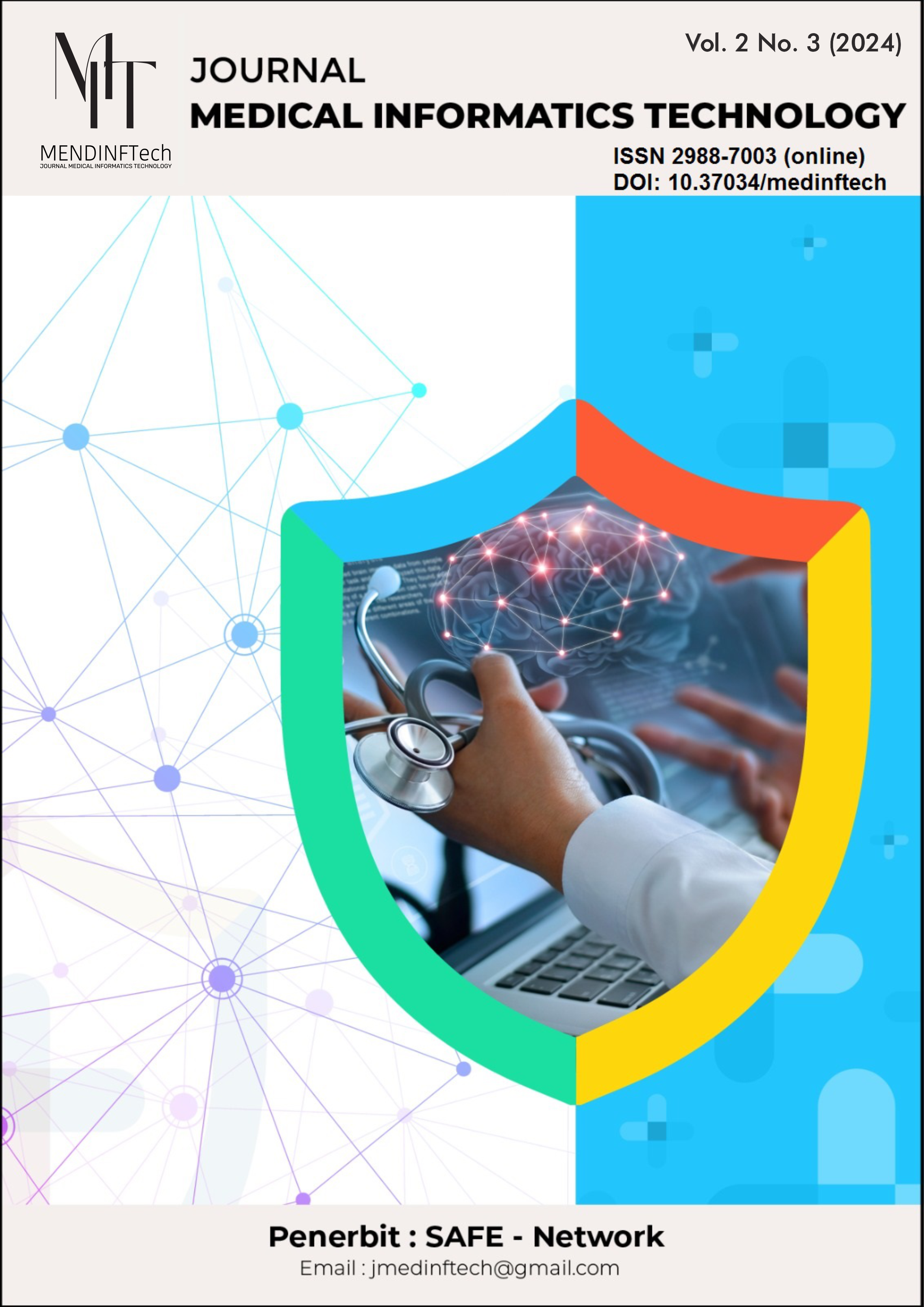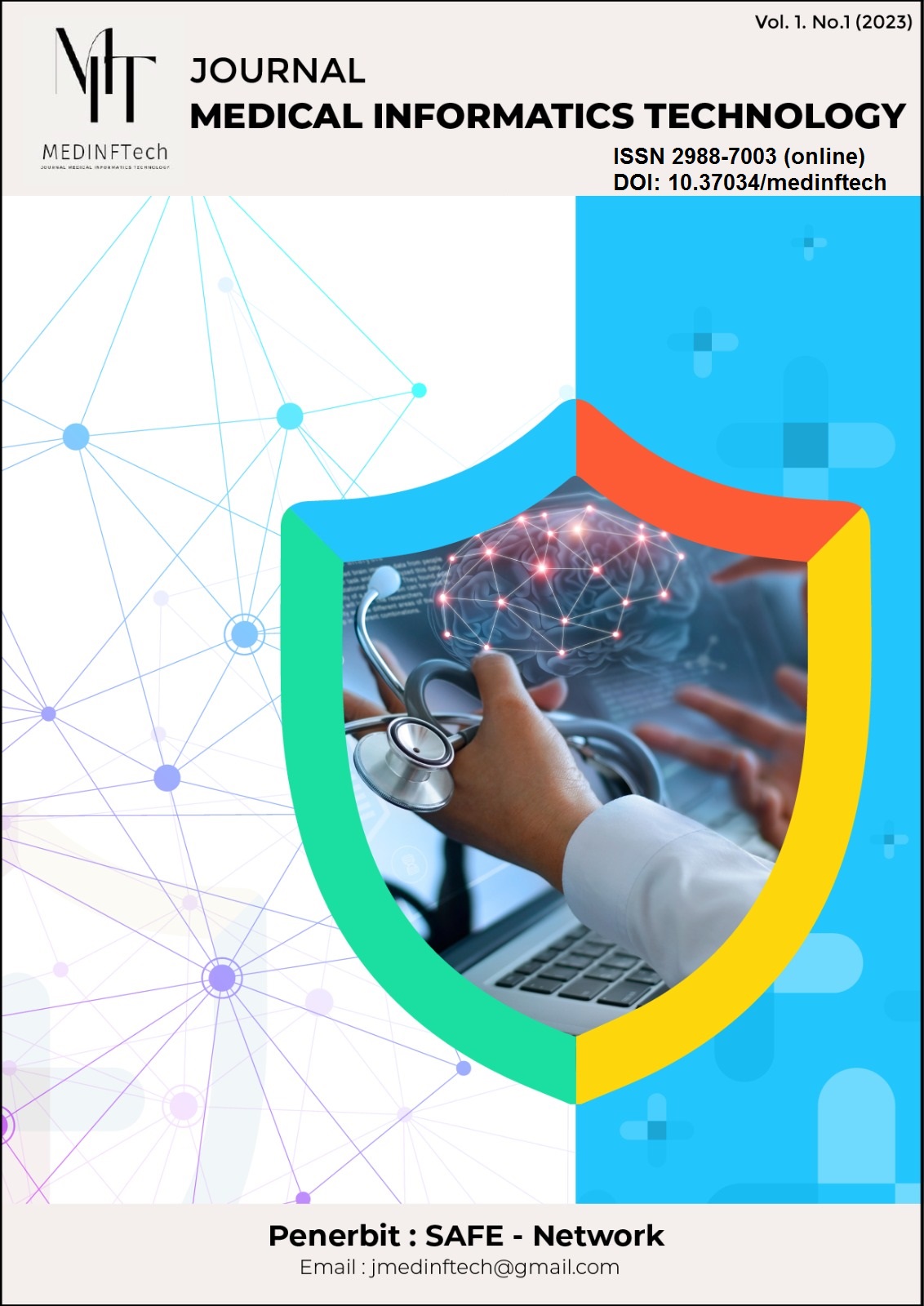Fragility Fracture of Proximal Tibia in A Wheelchair-Bound 54-Year-Old Female Patient
DOI:
https://doi.org/10.37034/medinftech.v2i3.61Keywords:
Fracture Risk, Fragility Fractures, Low Activity, Sedentary Behavior, osteophorosisAbstract
Sedentary behavior is one of the risk factors of fracture, in which mild activity was found to be inversely associated with hip, vertebral, and total fracture. Other study also found non-linear association of fracture risk with lower and higher physical activity was associated with higher risk of any fracture compared to a mean physical activity. In this study, we reported a 54-year-old wheelchair bound female with fracture on the proximal tibia cause by low-energy trauma. This research underscores the importance of early identification of fracture risk factors, especially in vulnerable populations such as older adults who are wheelchair-bound. Early interventions that include lifestyle changes, increased physical activity, and nutritional management are essential to prevent further fractures and improve bone health. Identifying the risk of fractures on elderly patient may be beneficial for prevention of fractures especially in wheelchair-bound elderly individual.
Downloads
References
J. A. Yani et al., “‘An Interdisciplinary Approaches to Evaluation, Reconstruction and Rehabilitation of Knee Meniscus Injury’ Physical Therapy Managament for Post Op Tibia Plateu Dextra: A Case Study,” Acad. Physiother. Conf. Proceeding, 2022.
M. S. Choudry, A. Daniel, T. Stead, R. Mangal, and L. Ganti, “Femoral insufficiency fracture related to bisphosphonate use,” Radiol. Case Reports, vol. 19, no. 1, pp. 122–125, 2024, doi: 10.1016/j.radcr.2023.09.092.
K. Stattin et al., “Fracture risk across a wide range of physical activity levels, from sedentary individuals to elite athletes,” Bone, vol. 153, no. March, 2021, doi: 10.1016/j.bone.2021.116128.
A. D. Woolf and K. Akesson, “Preventing fractures in elderly people,” Br. Med. J., vol. 327, no. 7406, pp. 89–95, 2003, doi: 10.1136/bmj.327.7406.89.
N. Joshi, O. Pujol, and S. Prat, “Complex distal femoral fractures in the fragile elderly patient treated by distal femoral replacement: A report of three cases,” Rev. Esp. Cir. Ortop. Traumatol., vol. 66, no. 2, pp. 149–153, 2022, doi: 10.1016/j.recot.2021.07.005.
P. Gahr, S. Kopf, and S. Pauly, “Current concepts review. Management of proximal tibial fractures,” Front. Surg., vol. 10, no. March, pp. 1–18, 2023, doi: 10.3389/fsurg.2023.1138274.
T. S. Pannu, J. M. Villa, E. M. Cohen, R. A. Hayda, C. A. Higuera, and M. E. Deren, “Periprosthetic Tibial Fractures After Total Knee Arthroplasty: Early and Long-Term Clinical Outcomes,” J. Arthroplasty, vol. 36, no. 4, pp. 1429–1436, 2021, doi: 10.1016/j.arth.2020.10.035.
H. Berven, M. Brix, K. Izadpanah, E. J. Kubosch, and H. Schmal, “Comparing case-control study for treatment of proximal tibia fractures with a complete metaphyseal component in two centers with different distinct strategies: Fixation with Ilizarov frame or locking plates,” J. Orthop. Surg. Res., vol. 13, no. 1, pp. 1–11, 2018, doi: 10.1186/s13018-018-0792-3.
A. M. Spungen et al., “The design of a randomized control trial of exoskeletal-assisted walking in the home and community on quality of life in persons with chronic spinal cord injury,” Contemp. Clin. Trials, vol. 96, no. August, p. 106102, 2020, doi: 10.1016/j.cct.2020.106102.
R. Korpelainen, P. Pinola, and J. Fridolfsson, “Gait & Posture Associations of accelerometer-estimated free-living daily activity impact intensities with 10-year probability of osteoporotic fractures in adults,” vol. 112, no. November 2023, pp. 22–32, 2024, doi: 10.1016/j.gaitpost.2024.05.002.
F. Migliorini et al., “Fragility Fractures : Risk Factors and Management in the Elderly,” pp. 1–9, 2021.
P. E. Schwab, A. Dessain, and J. Milby, “Monoclonal antibody anti-sclerostin for treatment of pelvic insufficiency fractures in adult hypophosphatasia: A case report,” Trauma Case Reports, vol. 53, no. July, p. 101077, 2024, doi: 10.1016/j.tcr.2024.101077.
D. Kwak and L. D. V. Thompson, “Frailty: Past, present, and future?,” Sport. Med. Heal. Sci., vol. 3, no. 1, pp. 1–10, 2021, doi: 10.1016/j.smhs.2020.11.005.
Wang, X., Hu, J., & Wu, D. Risk factors for frailty in older adults. Medicine, 101(34), 2022. https://doi.org/10.1097/MD.0000000000030169
A. Vahabi, H. Kaya, Z. Çağıran, M. C. Sözbilen, C. Kurt, and H. Günay, “Characteristics of femoral neck fractures in osteogenesis imperfecta: Series of four-teen consecutive hips in twelve patients,” Injury, vol. 55, no. 4, 2024, doi: 10.1016/j.injury.2024.111390.
S. Mitsutake, S. et al., “The role of frailty risk for fracture-related hospital readmission and mortality after a hip fracture,” Arch Gerontol Geriatr, p. 117, 2024, doi: 105264. https://doi.org/10.1016/j.archger.2023.105264.
E. Mustamsir et al., “Study Epidemiology of Risk Fracture in Osteoporosis Based on Frax Score and Osta Score, with Risk of Fall Using Ontario Score in Elderly Indonesia,” Public Heal. Res, vol. 11(3), 2022, doi: https://doi.org/10.1177/22799036221115777.
A. P. L. Tolley, K. A. Ramsey, A. G. M. Rojer, E. M. Reijnierse, and A. B. Maier, “Objectively measured physical activity is associated with frailty in community-dwelling older adults : A systematic review,” J. Clin. Epidemiol., vol. 137, pp. 218–230, 2021, doi: 10.1016/j.jclinepi.2021.04.009.
M. Mekki, A. D. Delgado, A. Fry, D. Putrino, and V. Huang, “Robotic Rehabilitation and Spinal Cord Injury: a Narrative Review,” Neurotherapeutics, vol. 15, no. 3, pp. 604–617, 2018, doi: 10.1007/s13311-018-0642-3.
M. Shao, Q. Wang, Q. Lv, Y. Zhang, G. Gao, and S. Lu, “Heliyon Advances in the research on myokine-driven regulation of bone metabolism,” Heliyon, vol. 10, no. 1, p. e22547, 2024, doi: 10.1016/j.heliyon.2023.e22547.
M. S. LeBoff et al., “The clinician’s guide to prevention and treatment of osteoporosis,” Osteoporosis International, vol. 33, no. 10, pp. 2049–2102, Apr. 2022, doi: 10.1007/s00198-021-05900-y.
S. J. Woolford, O. Sohan, E. M. Dennison, C. Cooper, and H. P. Patel, “Approaches to the diagnosis and prevention of frailty,” Aging Clinical and Experimental Research, vol. 32, no. 9, pp. 1629–1637, Apr. 2020, doi: 10.1007/s40520-020-01559-3.
E. M. Curtis et al., “Management of patients at very high risk of osteoporotic fractures through sequential treatments,” Aging Clinical and Experimental Research, vol. 34, no. 4, pp. 695–714, Mar. 2022, doi: 10.1007/s40520-022-02100-4.
D. young Cheon, K.-D. Han, J. H. Lee, K.-H. Yu, B. Y. Choi, and M. Lee, “Impact of changes in physical activity and incident fracture after acute ischemic stroke,” Scientific Reports, vol. 13, no. 1, Oct. 2023, doi: 10.1038/s41598-023-44031-8.









